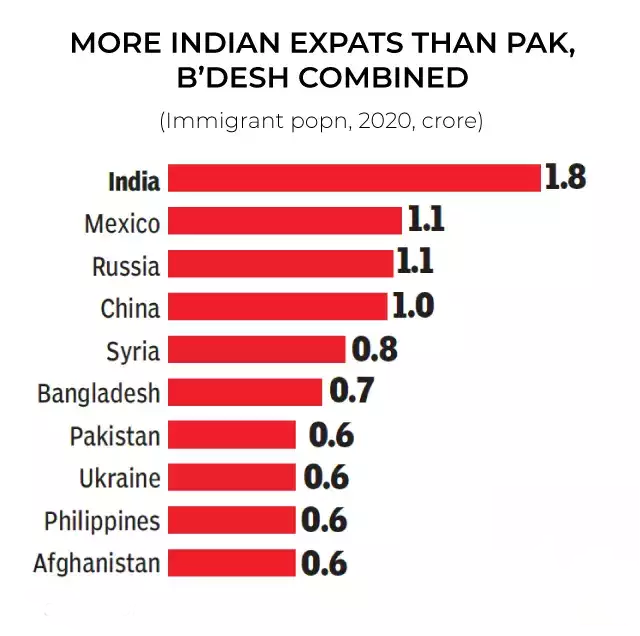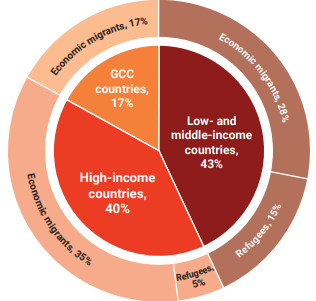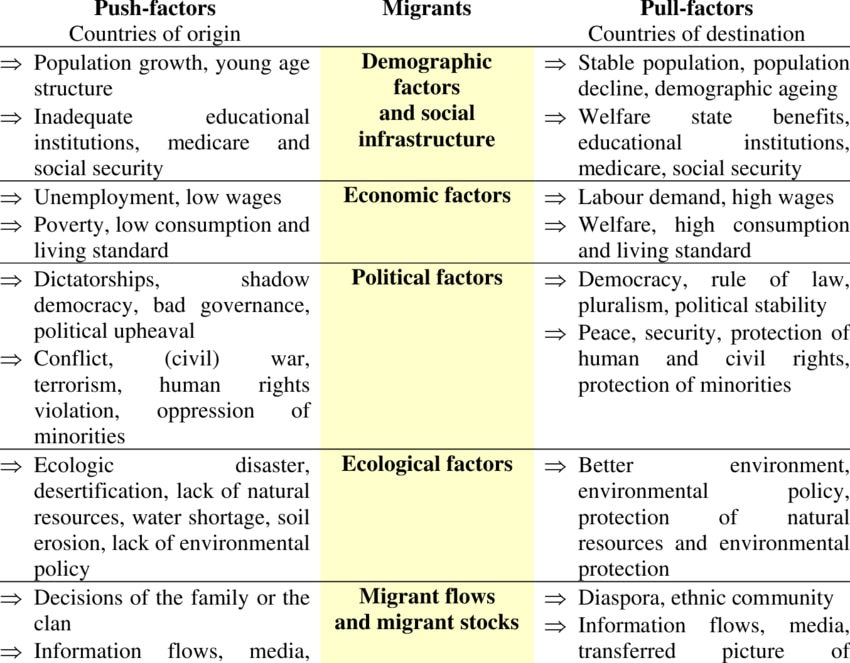Indian Society
Migration: Trends, Challenges, and Solutions
This editorial is based on “Migration matters” which was published in Business Standard newspaper on 13/05/2024. The article examines multidimensional aspects of Mobility, Both migration within the country and migration to other countries and the challenges lie within it.
For Prelims: World Migration Report, internal migration, International Organization for Migration, Global Compact for Safe, Orderly and Regular Migration, NITI Aayog, draft National Migrant Labour policy prepared, One Nation One Ration Card (ONORC) project, Affordable Rental Housing Complexes (ARHC), e-Shram portal, COVID-19, feminization of agriculture, current account deficit., public distribution system (PDS), PM Garib Kalyan Yojna scheme, Human Migration, Migration in India Report 2020-21
For Mains: Importance of Migration, Obstacles to Migration, need for a Policy Centered on Migration.
The latest World Migration Report, released by the International Organization for Migration, confirms that migration from India to the UAE, the US, and Saudi Arabia ranks among the top 10 country-to-country migration corridors and male emigration from India constitutes nearly 65% of total external migration, indicating that men often migrate for work while women tend to stay behind.
In 2020, approximately 18 million people from India were living outside their country of birth, the United Arab Emirates (UAE), the United States (US), and Saudi Arabia host the largest Indian diaspora, both internal migration within the country and migration to other countries are typically driven by the pursuit of improved livelihoods.
What is Migration?
- About:
- As per the International Organization for Migration's definition, a migrant is an individual who is relocating or has relocated across an international boundary or within a state, departing from their usual place of residence.
- Analysing changes in migration regarding scale, direction, demographics, and frequency can inform the development of impactful policies, programs, and practical interventions.
- Forms and Patterns of Migration:
- Internal migration: It occurs within a country, and can be categorised based on origin and destination, encompassing rural-urban migration, intra-state, and inter-state migration.
- External Migration: It also known as international migration, involves individuals or families moving from one country to another and can be driven by various factors, including economic opportunities ( Indian IT professionals in the US or construction workers in GCC nations), education, family reunification, or seeking asylum from persecution or conflict (Rohingya in Bangladesh)
- Emigration from India to various parts of the world.
- Immigration of people from different countries to India.
- Forced migration: It occurs when individuals or families are compelled to move due to factors like war, persecution, or natural disasters.
- Voluntary migration: It involves individuals or families choosing to relocate, often driven by better economic prospects or a desire for an improved quality of life.
- Temporary migration: It is intended to be of short duration, such as seasonal or temporary work, whereas permanent migration involves settling permanently in a new location.
- Reverse migration:It refers to individuals or families returning to their country of origin or original place of residence after previously migrating elsewhere.
What are the Various Reasons for Migration?
- Economic Factors:
- Push Factors: Economic difficulties like poverty, low productivity, and joblessness serve as push factors and make people want to leave where they are currently living, for example, farmers in Maharashtra facing low yields due to recurring droughts might migrate to cities like Pune or Mumbai for construction or service sector jobs.
- Pull Factors: On the other hand, prospects for better jobs, higher pay, and a better quality of life act as pull factors and attract people to move to a different place, for example, A young graduate from a village in Uttar Pradesh might migrate to Noida/Gurugram for a software development job due to the higher salary and the opportunity for a better life in the city.
- Socio-cultural Factors:
- Migration can be influenced by social factors such as marriage, family reunification, or the desire to be closer to one's community or social network.
- Examples include migration due to marriage or to escape caste-based discrimination and violence.
- Cultural factors Preservation:
- People may migrate to areas where their cultural practices, traditions, and beliefs are respected and preserved.
- For example, a community might move to a region where there is a strong presence of their ethnic or religious group, allowing them to maintain their cultural identity.
- Political Factors:
- Political instability, conflicts, and persecution can force individuals to migrate in search of safety and security.
- Factors such as government policies, administrative actions, and separatist movements can also influence migration patterns.
- Environmental Factors:
- Natural disasters, climate change impacts, deforestation, water scarcity, etc. can lead to migration by causing loss of homes, livelihoods, and resources.
- As a result, affected populations may be compelled to migrate in search of safety, sustainability, and improved living conditions.
- Some estimates suggest that India could experience significant migration of around 45 million people by 2050 due to the impacts of climate. Change.
- Developmental Projects: Projects like the Narmada Dam Project and the Ken Betwa River Linking Project lead to migration.
- For Example, Sardar Sarovar Project, a large multipurpose river project on river Narmada has displaced more than 40,000 families, primarily tribals from the 245 villages spread over three states of Gujarat, Madhya Pradesh and Maharashtra.
What are the Various Impacts Associated With Migration?
- Positive Impacts:
- Economic Growth:
- Migration can contribute to economic growth by filling labour gaps, boosting productivity, and increasing consumer spending.
- Migration results in remittances from migrants, which serve as a significant source of foreign exchange for the source region.
- In 2022, India was the largest recipient of remittances, receiving over $111 billion, which helped narrow the country's current account deficit.
- Social Impact:
- Migrants act as agents of social change, facilitating the spread of new ideas and technologies, such as family planning and education, from urban to rural areas.
- cultural diversity:
- Migration also fosters cultural diversity and contributes to the evolution of composite cultures, broadening people's perspectives.
- Migration enriches societies by bringing multiple languages, and traditions, fostering creativity and tolerance.
- Improving Quality of Life:
- Migration increases employment opportunities and economic well-being, thereby enhancing the overall quality of life for migrants.
- Innovation:
- Migrants often bring new ideas, skills, and technologies, driving innovation and entrepreneurship in host countries.
- Labor Market Flexibility:
- Migration can help balance labor supply and demand, particularly in sectors facing shortages of skilled workers.
- Economic Growth:
- Negative Impacts:
- Demographic Impact:
- Migration causes population redistribution within a country, particularly contributing to urban population growth, however, selective out-migration from rural areas can negatively affect and leads to feminization of agriculture, particularly in terms of age and skill distribution.
- Environmental Impact:
- Rural-urban migration leads to overcrowding in urban areas, straining existing infrastructure and resulting in unplanned urban growth and the emergence of slums. For example,Mumbai's massive slum population, estimated at over half the city's residents, is a direct result of rural-urban migration.
- Increased traffic congestion and dependence on informal waste disposal due to unplanned settlements contribute significantly to air and soil pollution in Indian cities.
- Social Tensions:
- Migration may exacerbate social tensions, including competition for jobs, housing, and social services, as well as cultural clashes and discrimination.
- Migration can lead to family separation, emotional distress, and disruption of social networks, particularly when family members are left behind in sending countries.
- Demographic Impact:
What are the Different Statistics on Migration in India?
- Migration in India Report 2020-21:
- The Ministry of Statistics and Program Implementation's report in June 2022 compiled data for temporary visitors and migrants, around 0.7% of the population was recorded as temporary visitors from July 2020 to June 2021.
- The all-India migration rate was 28.9% for the same period, with rates of 26.5% in rural and 34.9% in urban areas.
- The female migration rate stood at 47.9%, with 48% in rural and 47.8% in urban areas and the male migration rate was 10.7%, with 5.9% in rural and 22.5% in urban areas.
- 86.8% of female migrants migrated for marriage, while 49.6% of male migrants moved in search of employment.
- 2011 Census:
- India had approximately 45.36 crore internal migrants, accounting for 37% of the population.
- Annual net migrant flows represented about 1% of the working-age population and the country's workforce was estimated to be 48.2 crores, surpassing 50 crores by 2016.
- Report of the Working Group on Migration, 2017:
- 17 districts accounted for the top 25% of India's total male out-migration, with ten in Uttar Pradesh, six in Bihar, and one in Odisha.
What are the Various Challenges Associated with the Migration in India?
- Inadequate Social Security and Health Benefits: Migrant workers often lack access to essential social security and healthcare benefits and the enforcement of minimum safety standards laws in workplaces, exposing them to unsafe working conditions. For example, migrant construction workers in urban areas might lack access to proper safety equipment, increasing their vulnerability to accidents and injuries.
- Based on the 2021-2022 Periodic Labour Force Survey, over half (53%) of regularly employed non-agricultural workers in India lack social security benefits, encompassing migrant workers, self-employed individuals, and those working from home.
- Limited Portability of State-provided Benefits: Migrant workers face difficulties in accessing state-provided benefits, particularly essential food supplies distributed through the public distribution system (PDS). For example, migrant agricultural labourers may struggle to access subsidised food grains in their destination states due to residency requirements.
- Scarcity of Affordable Housing and Basic Amenities: Migrant workers migrating to urban areas often confront challenges in securing affordable housing and accessing basic amenities such as clean water, sanitation facilities, and electricity. This lack of access to adequate housing and infrastructure contributes to their vulnerability and perpetuates cycles of poverty.
- Impacts of the COVID-19 Pandemic: The COVID-19 pandemic has compounded the challenges faced by migrant workers. For example, migrant daily wage labourers stranded in urban centres during lockdowns faced acute hardships due to loss of income and lack of access to essential services.
- Exploitation and Discrimination: Migrant workers are often subject to exploitation and discrimination in the labour market and they may endure wage theft, hazardous working conditions, and discrimination based on their migrant status, ethnicity, or language.
- There have been instances of migrant workers facing violence and discrimination in Maharashtra, including those from Bihar.
- The 2008 attacks on Uttar Pradeshi and Bihari migrants in Maharashtra is a horrific example.
- There have been instances of migrant workers facing violence and discrimination in Maharashtra, including those from Bihar.
What are the Government Initiatives Regarding Migration?
- Initiatives like the draft National Migrant Labour policy prepared by NITI Aayog in 2021 discuss the importance of collective action to help migrants bargain for better conditions.
- Additionally, the One Nation One Ration Card (ONORC) project has been expanded, along with the introduction of the Affordable Rental Housing Complexes (ARHC) and the PM Garib Kalyan Yojna scheme.
- The launch of the e-Shram portal also brings promise to the migrant's status.
- The code on Social Security provides certain benefits for inter-state migrant workers such as Insurance and provident fund.
- International Migration and Global Action:
- In 2016 the United Nations General Assembly convened a high-level plenary meeting on addressing large movements of refugees and prepared the report “Safety and Dignity: Addressing Large Movements of Refugees and Migrants”.
- United Nations member states adopted the New York Declaration for Refugees and Migrants, which commits to protect the safety, dignity, human rights and fundamental freedoms of all migrants, regardless of their migratory status.
- As a result of the New York Declaration, UN Member States agreed to cooperate in the elaboration of a Global Compact for Safe, Orderly and Regular Migration, adopted at an intergovernmental conference on international migration in December 2018 in Morocco.
- Every year, 8th December is celebrated as International Migrants Day.
What Needs to be Done to Tackle the Challenges of Migration?
- Incorporating comprehensive social security measures:
- Providing Basic Amenities: Ensure the protection of migrants' rights, including access to housing, healthcare, education, and employment, regardless of their migration status. Schemes like Pradhan Mantri Awas Yojana (Urban) Mission for providing housing facilities in urban areas, and One Nation One Ration Card to fulfil the integrated food requirements of migrants.
- Integration and Inclusion: Promote integration and inclusion of migrants into society, fostering social cohesion and minimising discrimination and xenophobia.
- Skill Development & Job Creation: Investing in rural skilling initiatives to enhance employability and create job opportunities in villages can reduce the need for migration for work. Schemes like Skill India Mission, and Pradhan Mantri Kaushal Vikash Yojana can help to empower migrants.
- Counter Magnet Cities: By investing in infrastructure, amenities, and economic opportunities in regional cities, governments should aim to promote balanced regional development and reduce pressure on major urban hubs by offering employment opportunities, affordable housing, quality education, healthcare facilities, and a better standard of living.
- By dispersing population growth across multiple cities, rather than concentrating it in a few, counter-magnet cities help alleviate congestion, reduce strain on resources, and ease the burden on infrastructure in overpopulated areas.
- Labour Market Policies: Develop labour market policies that safeguard the rights of migrant workers, including fair wages, safe working conditions, and access to social security benefits.
- Regulation and Worker Protection: Strictly enforce labor laws to protect migrant workers from exploitation. This includes ensuring fair wages, safe working conditions, and proper grievance redressal mechanisms.
|
Drishti Mains Question "What are the implications of internal migration on urbanisation and infrastructure development in India?" |
UPSC Civil Services Examination, Previous Year Questions (PYQs
Q. Discuss the changes in the trends of labour migration within and outside India in the last four decades. (2015)







